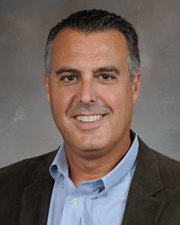Morano Lab

Kevin Morano, Ph.D.
Protein quality control and stress response
Protein folding in the cell is a complex and dynamic process, and the environment that a nascent polypeptide encounters during synthesis is challenging – the protein concentration of the cytosol can be up to 300 mg/ml. Best estimates suggest that upwards of 3 million ribosomes are at work generating the eukaryotic proteome, making the correct synthesis, folding and assembly of proteins a fundamental problem. In humans, disorders linked to protein misfolding include Alzheimer’s, Parkinson’s, Lou Gehrig’s diseases, prion-based disease, multiple triplet-repeat class ataxias and type II diabetes. Protein misfolding is also intimately linked with aging and is a primary factor influencing the “health span” of an organism. Therefore an urgent need exists to both understand and control the cellular processes governing protein quality control (PQC). We use the model eukaryoteSaccharomyces cerevisiae, or baker’s yeast, to tackle these problems as nearly all the relevant pathways and players are highly conserved with humans, and this experimental system allows us to utilize biochemical, genetic, genomic and cell biological approaches.
Work in our laboratory focuses on two distinct areas:
- 热休克蛋白质的角色和监管n 70 (Hsp70) protein chaperone
Hsp70 is a ubiquitous and prototypical member of the class of PQC factors known as molecular chaperones. In iterative cycles governed by ATP binding and hydrolysis, Hsp70 binds unfolded polypeptides and shields them from aggregation, subsequently releasing them for spontaneous folding. This powerful machine is in turn regulated by a number of co-factors including ATPase activating proteins, most notably those of the DnaJ family, and an array of unrelated nucleotide exchange factors (NEF). Our lab established that the Hsp110 class of chaperone functions as an NEF as part of a heterodimeric complex with Hsp70 in yeast. We have been studying biochemical and cellular aspects of this partnership and have expanded our inquiries to include two other NEFs: the yeast homologs of HSPBP1 and the Bag subfamily. Unique among the known NEFs, Hsp110 (known as Sse1 in yeast) possesses a substrate-binding domain of its own whose contribution to protein folding and PQC is unknown. We are currently working to establish what roles substrate binding by Sse1, and by extension, human Hsp110, may play within cells. - Mechanism and control of the cytoplasmic unfolded protein response (cUPR)
In response to proteotoxic stress, all eukaryotes activate a broad-ranging transcriptional program that includes hundreds of cytoprotective genes. In both yeast and humans, this response is controlled by the heat shock transcription factor HSF1. Despite over 30 years of research, it is still unknown precisely how HSF1 senses diverse forms of stress. This question is of key clinical relevance, as HSF1 activation enables tumor formation and metastasis, while at the same time promoting clearance of misfolded cytotoxic proteins and slowing aging in model systems. There is thus great interest in the potential for pharmacological manipulation of HSF1 to inhibit or enhance the cUPR for therapeutic benefit. We are investigating HSF1 regulation at its most fundamental level: a negative feedback loop with protein chaperones serving as direct repressors of transcriptional activation. We have found that Hsp70 acts as a proximal sensor for reactive oxygen species and other thiol-reactive xenobiotics via reactive cysteines located in the ATP binding domain, and are testing the hypothesis that regulation of Hsp70 activity may directly control HSF1.